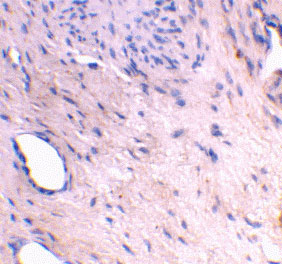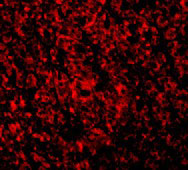ARMER Antibody
- 产品详情
- 实验流程
- 背景知识
Application
| WB, IF, E, IHC-P |
|---|---|
| Primary Accession | Q15041 |
| Other Accession | Q15041, 14424435 |
| Reactivity | Human, Mouse |
| Host | Rabbit |
| Clonality | Polyclonal |
| Isotype | IgG |
| Calculated MW | 23363 Da |
| Concentration (mg/ml) | 1 mg/mL |
| Conjugate | Unconjugated |
| Application Notes | ARMER antibody can be used for detection of ARMER by Western blot at 0.5 to 2 µg/mL. Antibody can also be used for immunohistochemistry starting at 2 µg/mL. For immunofluorescence start at 2 µg/mL. |
| Gene ID | 23204 |
|---|---|
| Other Names | ARMER Antibody: AIP1, ARMER, SPG61, ARL6IP, KIAA0069, ADP-ribosylation factor-like protein 6-interacting protein 1, ARL-6-interacting protein 1, ADP-ribosylation factor-like 6 interacting protein 1 |
| Target/Specificity | ARL6IP1; |
| Reconstitution & Storage | ARMER antibody can be stored at 4℃ for three months and -20℃, stable for up to one year. As with all antibodies care should be taken to avoid repeated freeze thaw cycles. Antibodies should not be exposed to prolonged high temperatures. |
| Precautions | ARMER Antibody is for research use only and not for use in diagnostic or therapeutic procedures. |
| Name | ARL6IP1 |
|---|---|
| Function | Positively regulates SLC1A1/EAAC1-mediated glutamate transport by increasing its affinity for glutamate in a PKC activity- dependent manner. Promotes the catalytic efficiency of SLC1A1/EAAC1 probably by reducing its interaction with ARL6IP5, a negative regulator of SLC1A1/EAAC1-mediated glutamate transport (By similarity). Plays a role in the formation and stabilization of endoplasmic reticulum tubules (PubMed:24262037). Negatively regulates apoptosis, possibly by modulating the activity of caspase-9 (CASP9). Inhibits cleavage of CASP9-dependent substrates and downstream markers of apoptosis but not CASP9 itself (PubMed:12754298). May be involved in protein transport, membrane trafficking, or cell signaling during hematopoietic maturation (PubMed:10995579). |
| Cellular Location | Endomembrane system; Multi-pass membrane protein. Endoplasmic reticulum membrane; Multi-pass membrane protein. Endoplasmic reticulum {ECO:0000250|UniProtKB:Q9JKW0}. Note=Predominantly localized to intracytoplasmic membranes. Preferentially localizes at the ER tubules and the edge of the ER sheets, both of which are characterized by a high membrane curvature. |
| Tissue Location | Expressed in all hematopoietic cell lineages, but the highest level of expression is found in early myeloid progenitor cells. Expressed in brain, bone marrow, thymus and lung. Expressed at low level in liver, kidney and spleen. Not detected in heart |
For Research Use Only. Not For Use In Diagnostic Procedures.
Provided below are standard protocols that you may find useful for product applications.
BACKGROUND
ARMER Antibody: Apoptosis is important for normal development and tissue homeostasis. It is mediated by various caspases and ultimately results in the activation of endogenous endonucleases that degrade cellular DNA. Although apoptosis induced by endoplasmic reticulum (ER) stress is thought to be mediated by caspase-12, other caspases such as caspase-9 are also thought to be activated following ER stress. Recently, ARMER, a novel integral ER-membrane protein was shown to protect cells from ER stress-induced apoptosis. Analysis of the caspase proteolytic cascade suggests that ARMER acts by inhibiting caspase-9 activity, although the mechanism for this remains unkown. It should be noted that ARMER is not related to the inhibitor of apoptosis proteins (IAP) family and does not contain any baculoviral IAP repeat (BIR) domains.
REFERENCES
Stellar H. Mechanisms and genes of cellular suicide. Science 1995; 267:1445-9.
Nakagawa T, Zhu H, Morishima N, Li E, Xu J, Yankner BA, Yuan J. Caspase-12 mediates endoplasmic-reticulum-specific apoptosis and cytotoxicity by amyloid-β. Nature 2000; 403:98-103.
Lui HM, Chen J, Wang L, et al. ARMER, Apoptotic regulator in the membrane of the endoplasmic reticulum, a novel inhibitor of apoptosis. Mol. Cancer Res. 2003; 1:508-18.
终于等到您。ABCEPTA(百远生物)抗体产品。
点击下方“我要评价 ”按钮提交您的反馈信息,您的反馈和评价是我们最宝贵的财富之一,
我们将在1-3个工作日内处理您的反馈信息。
如有疑问,联系:0512-88856768 tech-china@abcepta.com.























 癌症的基本特征包括细胞增殖、血管生成、迁移、凋亡逃避机制和细胞永生等。找到癌症发生过程中这些通路的关键标记物和对应的抗体用于检测至关重要。
癌症的基本特征包括细胞增殖、血管生成、迁移、凋亡逃避机制和细胞永生等。找到癌症发生过程中这些通路的关键标记物和对应的抗体用于检测至关重要。 为您推荐一个泛素化位点预测神器——泛素化分析工具,可以为您的蛋白的泛素化位点作出预测和评分。
为您推荐一个泛素化位点预测神器——泛素化分析工具,可以为您的蛋白的泛素化位点作出预测和评分。 细胞自噬受体图形绘图工具为你的蛋白的细胞受体结合位点作出预测和评分,识别结合到自噬通路中的蛋白是非常重要的,便于让我们理解自噬在正常生理、病理过程中的作用,如发育、细胞分化、神经退化性疾病、压力条件下、感染和癌症。
细胞自噬受体图形绘图工具为你的蛋白的细胞受体结合位点作出预测和评分,识别结合到自噬通路中的蛋白是非常重要的,便于让我们理解自噬在正常生理、病理过程中的作用,如发育、细胞分化、神经退化性疾病、压力条件下、感染和癌症。








